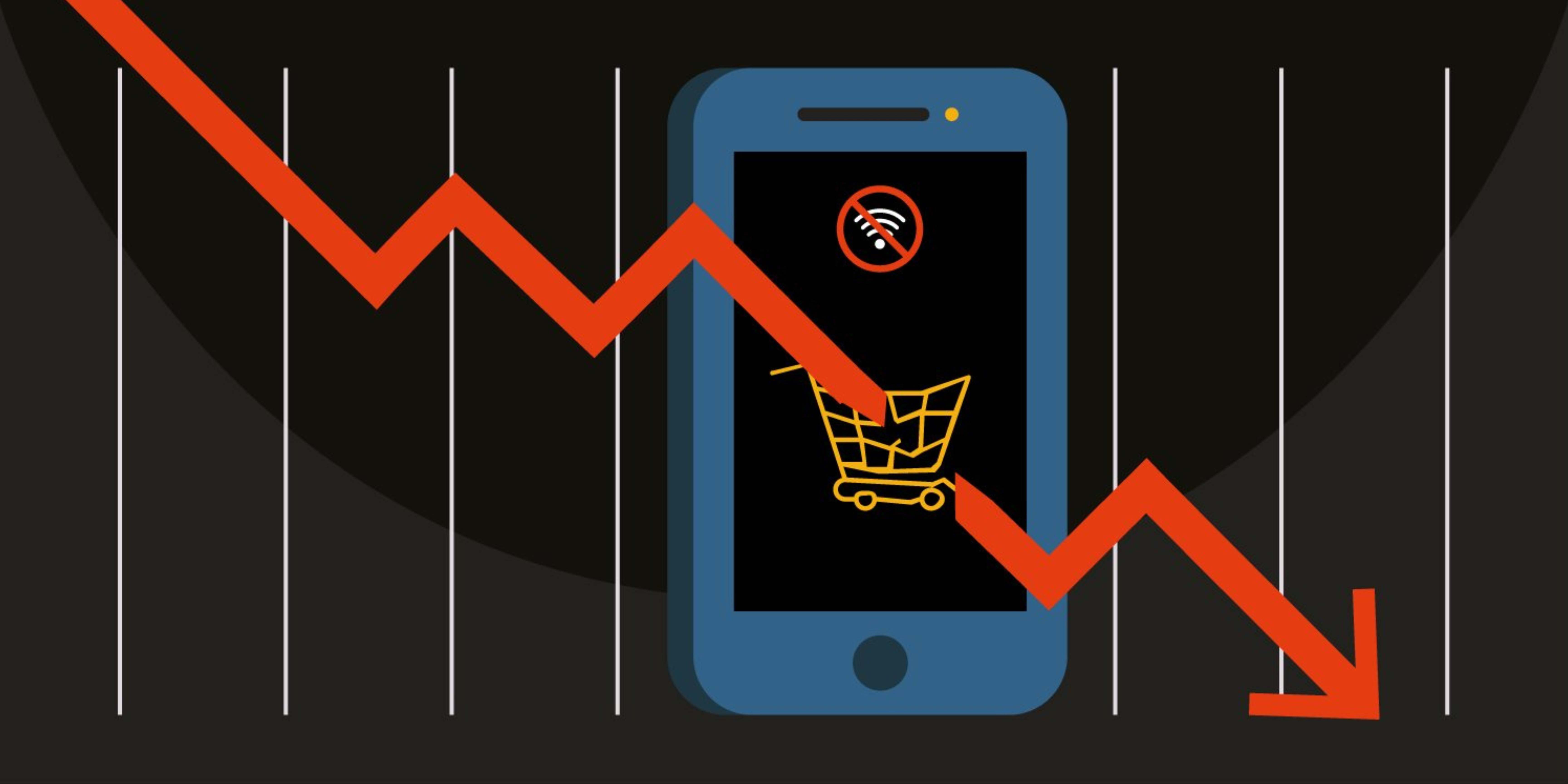Internet shutdowns, regardless of their severity, have always led to economic damage in Iran. In addition to internet shutdowns, it looks like we are living in a new norm of online censorship and blocking access to the internet.
Since the tragic death of Jina (Mahsa) Amini in the custody of Iran’s so-called Morality Police in September 2022 and the protests that followed, access to the internet in Iran has been in a state of near-constant crisis. At the height of violent crackdowns against protests, authorities introduced further internet restrictions, including digital curfews, localized shutdowns, the blocking of platforms such as WhatsApp and Instagram, the blocking of app stores, and aggressive attacks on access to VPNs. The impact that these oppressive measures have had on Iran’s digital economy has been devastating.
Smaller businesses have had to shut down or operate at a fraction of capacity due to continuing economic chaos, the security establishment’s pressure on IT industry activists, as well as the blocking of Instagram.
According to statistics provided by online market experts in Iran, from September to December 2022 around 400,000 businesses on Instagram went under, and just one month after the start of protests, internet filtering and disruptions caused 8 trillion Tomans(approximately $190 million at December 2022 market rate) in losses to internet companies.
In response, the Islamic Republic denied the existence of internet disruptions, and instead offered an economic support package to help businesses affected by internet disruptions – although it rejected the private sector’s loss estimate as “unprofessional.”
In the latest response to this issue, ICT Minister Eisa Zarepour claimed in an interview with ISNA news agency, that the increase in postal service operations indicated that most online businesses were product-centric, and a significant portion of their products were distributed by post. He concluded that the increase in trade and the number of postal parcels showed that these companies “have found their way” and are moving forward.
Meanwhile businesses continue to have problems. Fandogh, a cloud-based infrastructure provider, announced in April 2023 that it was forced to shut down due to infrastructure problems and migration of human resources.
Also, Hanapp, a startup providing services for the hearing impaired, announced a few days after the ICT Minister’s interview in April 2023, that it was forced to shut down due to internet disruptions and poor quality of access.
This report provides greater details regarding losses incurred by the digital economy as a result of government deployed shutdowns and censorship targeting the “Woman, Life, Freedom” movement.
Online Market Volume Estimate
Due to the serious discrepancies between state and private sector statistics, along with the lack of independent and reliable data, estimating the number of active online businesses in Iran is not a simple task.
One of these statistics is related to a report published by the National Center for Cyberspace in November 2022 about the status of businesses on Instagram.
The report finds Persian-language Instagram to be a small market that constitutes just 6% of Iranians’ online purchases and sales, with a trade volume – selling clothing, handicrafts, cosmetics, hygiene products, jewelry, and educational services – at 25 trillion tomans per year (approximately $595 million).
Private firm’s look at small businesses on Instagram
Pashootan Pourpezeshk, CEO of Podro, a startup providing logistics to Instagram businesses, presented a report in June 2023 on the losses caused by Instagram filtering and internet restrictions following the “Woman, Life, Freedom” movement.

Podro provides several different services to online businesses. Its target audience are small businesses that need help to start up and provide services. Their clients can be categorized as small Instagram businesses. The statistics provided by Pourpezeshk are important in that they depict the state of small online businesses in terms of their sales from the perspective of a private firm.
Pourpezeshk stated that the severe internet bandwidth restrictions in August 2022, before the start of the movement, resulted in a decrease in the sales of Instagram vendors by 50%, and up to 30% of these businesses disappeared.
After Instagram was filtered, 90% of the vendors lost up to 100% of their sales, and their growth came to a halt. According to Pourpezeshk, an Instagram vendor who could earn up to 50 million tomans ($1,190) per month lost all his income.
One of Podro’s services also came to a grinding halt after Instagram was filtered, and another of its services had about an 80% drop in operations.
According to Pourpezeshk, of the estimated 630,000 Iranian vendors active on Instagram before it was filtered, only about 220,000 remained standing in December 2022. In other words, in about three months, more than 400,000 businesses “temporarily or permanently left Instagram,” canceling up to 50 trillion tomans ($119 million) in sales per day.
Other Instagram-based businesses focused on marketing as one of the ancillary services required by startups rather than direct commerce.
Instagram Marketing
An Instagram marketing and advertising expert in Iran, who asked to remain anonymous, told Filterwatch: “After the [protest] movement began in Iran, many Instagram pages that had previously made income through advertising and marketing, changed their line of work. Due to audience demand, the content of these pages shifted from product advertising to news dissemination and everyone’s income dropped to zero.”
The income of this Filterwatch source fell from at least 30 million tomans ($ 714) per month to zero. He recently resumed his work, but not earning as much as he did previously.
This trend lasted for at least three months after the protests began. Later, the vendors’ pages gradually resumed previous activities, but due to internet disruptions and increased filtering, the visitor count did not return to the former levels, affecting the earnings of many people.
One Iranian Instagram vendor, who lives abroad and attracts advertisements from both inside and outside of Iran, told the following to Filterwatch on condition of anonymity: “Due to the economic conditions and decreasing interest in advertising, practically no ads can be attracted from inside Iran. Many of our pages were showing solidarity with people during the protests. For this reason, travel agencies, hotels, etc., who were our top customers, are no longer willing to work with us. We are now forced to get ads from Iranian companies outside the country, which do not bring much income.”
Many Instagram marketing businesses, inside and outside the country, operate without a government license. For this reason, although they have been affected by internet disruptions, they are not included in the statistics for harmed businesses.
The Computer Trade Association’s perspective
According to Hassan Hashemi, head of the Computer Trade Association of Iran, despite lack of precise statistics on online trade, “the income of 11 million people is directly and indirectly tied to Instagram.” He said three million online businesses should also be added to this figure.
Official businesses registered with the Ministry of Industry receive a license to operate the “E-Namad” electronic payment system as an internet gateway for conducting sales.
E-Commerce Development Center stats
Amin Kolahdouzan, head of the E-Commerce Development Center (TETA), said government statistics for the Iranian year 1400 (March 2021-2022), show that between 300,000 to 350,000 people have e-commerce pages on Instagram, creating 600,000 to 800,000 jobs, with a turnover of between 25 to 30 trillion tomans ($596 million and $716 million), which is about 2.7% of the total e-commerce in the country. Therefore, based on these statistics, the total official Iranian e-commerce market in that year came to 1,230 quadrillion tomans ($29.355 trillion)
TETA’s statistics are significant because they belong to a state supervisory body that was established by merging several national centers in the digital business field, and is responsible for the implementation and development of e-commerce using national and international facilities and standards. The center is authorized to issue e-business certifications and permits, including for the E-Namad online payment system.
The government supports these official businesses but only if they decide to operate in the country’s domestic platforms.
Based on statements by government officials, it can be surmised that compensation for harmed businesses covers those that have an E-Namad online business license and provide their statistics to state entities such as the E-commerce Development Center, or are considered legal businesses by the government as a result of obtaining a license. However, many income-generating activities on Instagram and social networks take place without a state license. Thus there is a significant difference between government statistics and reality.
Financial Loss Statistics
Apart from business statistics, different figures have been provided by the state and private sectors regarding the losses inflicted on online vendors.
Shahab Javanmardi, Deputy Chair of the Tehran Chamber of Commerce Committee for Innovation and Digital Transformation, said in a press conference in March 2023 that the government does not accept the amount of losses inflicted on private companies.
Regarding losses inflicted on businesses, Mojtaba Tavangar, the head of Parliament’s Technology and Digital Economy Committee, sent a letter to ICT Minister Eisa Zarepour complaining about a 40% decrease in internet operators’ revenue after the “Woman, Life, Freedom” movement and said the increase in domestic traffic could not compensate for the drop in revenue.
State: “Loss stats are incorrect”
Responding to the letter from the Member of Parliament, Zarepour dismissed the statistics as baseless and unprofessional, and stated that according to the Tehran stock exchange financial reports, the amount of losses is incorrect. He referred to an interview with the CEO of a domestic operator, who said revenues during this period decreased by 10-15%, but nine-month income increased compared to the previous year.
This contradicts financial statements from the telecommunications provider MCI (Hamrah-e Aval), especially in September and October 2022, which show a revenue drop of several hundred billion tomans (several millions of dollars).
Despite denials by government officials, their own reports on the business climate show that overall sales of online businesses had fallen.
Statistics gathered by the Shaparak government electronic payment portal can be a better barometer of business conditions in Iran. For the month of Dey 1401 (December 22, 2022 – January 20, 2023), it showed that online transactions dropped 2.83% compared to the previous month and was 10.91% lower than the same month a year earlier. For the previous month of Azar (November 22, 2022 – December 21, 2022), the real value of transactions fell 15.96% compared to the same month in 2021.
The report of Shaparak showed on November 2023,
Shaparak’s report only in the Persian month of Dey 1401 (December 22, 2022 – January 20, 2023) also showed that compared to the previous month, the number of unsuccessful transactions increased by 3%.
Farzin Fardis, Chairman of the Tehran Chamber of Commerce Committee for Innovation and Digital Transformation, announced in October 2022, that the total shutdown of the internet for a month after the protests resulted in about 80 trillion tomans ($1.9 billion) in losses to online businesses. Of this amount, he added, 35 trillion tomans ($833.33 million) was from direct impact to the information technology sector, and 45 trillion tomans ($1.07 billion) to businesses that use the services of the first group.
For example, in the month of Dey 1401 (December 22, 2022 – January 20, 2023), online service providers in the transportation, information, and communication sectors, had the lowest level of sales compared to the three months prior.
In general, state officials exclusively point to examples of progress and areas of success while turning a blind eye to losses incurred by online businesses.
On January 25, 2023, Reza Assadi-Fard, the head of the Center for Startup Companies and Institutions, operating under the Vice President’s Office for Science and Technology, said: “So far more than 8,012 tech companies have been approved, and in 2023 we had a record increase in their number. Every month 800 companies are evaluated and the processing time has significantly decreased.”
In response, Reza Olfatnasab, a board member of Virtual Businesses Association, told Entekhab newspaper, “It’s unclear what these statistics are based on, but the situation facing online startup businesses is not good because of their reliance on the internet. Many of them have shut down or are on the verge of collapse.” He noted that workforce downsizing and sales decline are also significant, but are not pointed out by state officials.
In another response, Abolfazl Sadegh, the Computer Guild’s head of game developers, told Entekhab website, on February 1, 2023, “More than 60% of the computer game developers’ income derives from Google Play, which has now been eliminated due to filtering and cutting off players’ access.” He did not provide any figures, but said that filtering in the past two or three months had “dried up the roots of game development.”
The ICT Minister responded that the authority for removing the filter rests with the Committee for Determining Criminal Content, not his ministry. At the same time, the ICT Ministry has tried to keep this large and young sector of Iranian society satisfied by offering tiered internet service for gamers, in order to align more individuals with the state’s restrictive policies.
A report by the Iran Computer Trade Union Organization (NASR) in November 2022 showed that as a result of internet restrictions following Mahsa Amini’s tragic death, between 50 to 500 million tomans ($1,190 to $11,904) of financial loss was inflicted daily on every online business. Based on the report, 53% of businesses lost 50 million tomans daily ($1,190), 21% lost between 50 to 100 million tomans ($1,190 to $2,380), about 18% lost between 100 to 500 million tomans ($2,380 to $11,904), and nearly 8% lost more than 500 million tomans ($11,904) per day.

In its study, NASR concluded that if the number of employees is considered as an indicator of the company size, it can be said that almost 8% of companies that have a workforce of more than 200 will likely see daily losses of over 500 million tomans ($11,904), and the 73% that have fewer than 50 personnel, will see daily losses of 50 million tomans ($1,190).
Foreign reporting on economic losses in Iran
In addition to domestic media coverage, global statistics and reports also indicated significant financial losses in Iran resulting from internet disruptions and shutdowns in 2022. A significant portion of these disruptions occurred after the start of the “Woman, Life, Freedom” movement, thus the relevant statistics are mostly associated with the losses after the protests.
Research conducted by Statista on the status of the internet worldwide in 2022, using data from Top10 VPN, showed that intermittent nationwide internet shutdowns in Iran affected nearly 72 million people and caused $773 million (30,566 billion tomans) in losses. According to these statistics, Iran is second in the world in terms of the volume of financial loss and people affected by internet disruptions and shutdowns. Russia, with a far greater population and geographic area, is first on this list.
Top10 VPN concentrated its research based on studies and reviews regarding issues in VPN software, internet censorship, digital rights, and cybersecurity.
Report from under the skin of startups; Nothing is as it used to be
Martech, a tech marketing firm, examined the losses caused by internet shutdowns in Iran from a social perspective in discussion with marketing experts. Its report points out significant drops in revenue in the first three months after the start of protests, job cuts and migration of specialist human resources, changes in the target market of internet businesses, and career changes of marketing professionals in internet businesses, as some of the major consequences of extensive online disruptions and filtering that intensified after the start of the “Woman, Life, Freedom” movement.
Nazanin Mokri, a social network marketing specialist, told Martech that scarcity of specialists had also affected this field.
Using a VPN to access social media content led to the return of visitors, but according to Nazanin Mokri, “conditions for social media marketers have not yet returned to normal as most users, impacted by current social conditions, don’t have much desire to view commercial content on social networks.”




